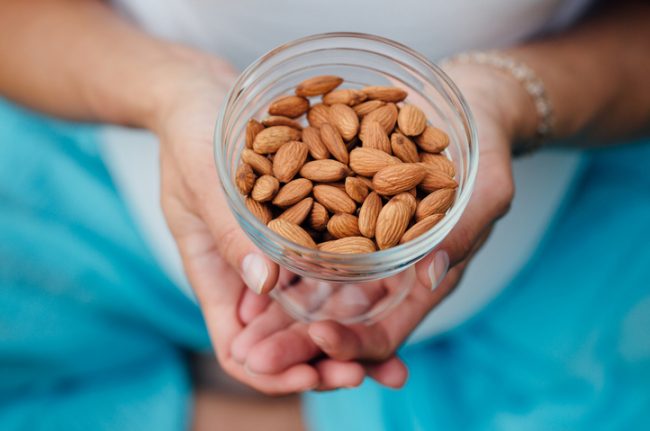Almonds have become the other California staple. In fact, almonds surpassed wine to become the number one state agricultural export in 2014. And there’s good reason for that.
With common gluten and peanut allergies on the rise, almonds have stepped in to fill a void. PB & J sandwiches are now being swapped for almond butter. Paleo and keto diet followers are enjoying baked goods made with gluten-free, low-carb almond flour. Even chefs and skincare experts have found uses for almonds, using the nut’s oil for cooking veggies and moisturizing dry skin.

Can all these people be wrong about the benefits of almonds?
No, they’re all right on point.
The benefits of almonds are nutty
Just one serving of almonds is a good source of vitamins and minerals, including magnesium, phosphorus, vitamin E and potassium. And if you’re looking for a low-carb snack that will fill you up, these tasty nuts can do just that. They’re high in fiber, low in sodium (if unsalted) and have a moderate amount of protein to eliminate those hunger pains and prevent overeating.
While almonds are an ideal snack for just about anyone, they’re especially great for diabetics. The creamy, crunchy nut helps regulate blood sugar levels. They can also help regulate blood pressure, promote healthy kidney function and protect your heart by lowering your LDL (aka the “bad”) cholesterol, which reduces your risk for cardiovascular disease.
There are countless ways to enjoy almonds
If you weigh out almonds on a food scale, 1 ounce is the perfect portion. For those who prefer counting or using measuring cups, 1/4 cup or 23 almonds is the equivalent to one serving. One serving provides about 160 calories, so try to stick to one serving and pair it with an apple or banana chips.
You can easily carry around these crunchy nuts for a heart-smart anytime snack, but they aren’t just for snacking. Here are some other ways to enjoy almonds:
- Top yogurt, cereal and salad with whole or slivered almonds for added crunch.
- Try swapping peanut butter for almond butter. But first check the ingredients for added sugar or trans fat, including molasses, honey and partially hydrogenated oils.
- Add a handful of almonds to smoothies for a dose of protein and healthy fats.
- Swap cow’s milk for unsweetened almond milk in your cup of coffee or cereal bowl if you want a lower-calorie, lower-carbohydrate option.
- Use crushed almonds as a crust for fish sticks or chicken tenders to create a lighter, kid-friendly meal.
- Substitute crushed almonds for bread crumbs when making meatballs.
- For low-carb or gluten-free baked goods, swap 25% of the all-purpose flour in the recipe for almond flour or almond meal.
